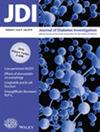A nomogram incorporating clinical and laboratory indicators for predicting metabolic dysfunction-associated fatty liver disease in newly diagnosed type 2 diabetes patients
Abstract
Aims
To develop and validate a nomogram model based on clinical and laboratory parameters to predict the risk of metabolic dysfunction-associated fatty liver disease (MAFLD) in the early stage of type 2 diabetes.
Materials and Methods
We performed this study among 883 inpatients with new-onset type 2 diabetes, and the data were divided randomly into training and validation groups. The logistic regression method was used to identify the independent risk factors of MAFLD, and a nomogram was established according to the logistic regression analysis and these selected parameters. The discrimination, calibration, and clinical utility of the nomogram were measured by receiver operating characteristic curve analysis, calibration curves, and decision-curve analysis, respectively.
Results
Eight variables were identified and included in the nomogram (body mass index, alanine aminotransferase, triglyceride, low-density lipoprotein cholesterol, high-density lipoprotein cholesterol, fasting plasma glucose, urea nitrogen and serum uric acid). The value of the area under the receiver operating characteristic (ROC) curve was 0.898 for the training group and 0.92 for the validation group. The calibration plots indicated that this model had good accuracy, and the decision-curve analysis revealed high-clinical practicability of the nomogram.
Conclusions
This study established a convenient and practical nomogram model, which can be used as an easy-to-use tool to evaluate the risk of MAFLD among patients with newly diagnosed T2DM.


 求助内容:
求助内容: 应助结果提醒方式:
应助结果提醒方式:


